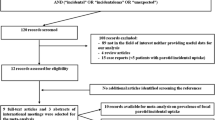Abstract
Purpose
We aimed to evaluate the frequency and malignancy rate of incidental salivary gland lesions (ISGLs) in patients undergoing 18F-fluorodeoxyglucose (FDG)–positron emission tomography/computed tomography (PET/CT).
Methods
Using a predefined algorithm, all descriptions of FDG–PET/CT scans performed in the North Denmark Region at the Department of Nuclear Medicine, Aalborg University Hospital from 1.12 2009 to 31.12 2019 were electronically searched for focal uptake in one or more salivary glands.
Results
In total, 28,362 FDG–PET/CT scans were performed in the study period. ISGLs were found in 197 (0.7%). A total of 193 (98%) had parotid gland ISGL, and four (2%) had submandibular ISGL. No sublingual lesions were found. Ultimately, 117 patients (60%) were referred to the Department of Otorhinolaryngology–Head and Neck Surgery for evaluation. Fine needle aspiration biopsy was performed in 97 patients, and the most frequent cytopathology was Warthin’s tumour (n = 62). Two patients had verified malignancy: one with histopathologically proven acinic cell carcinoma and one with cytopathologically proven metastasis from an oral squamous cell carcinoma.
Conclusions
Incidental salivary gland findings on FDG–PET/CT are rare, and the risk of malignancy is low. Patients with ISGL may be evaluated secondary to the primary disease, but special attention should be given to patients with prior or known head-and-neck malignancies and patients with symptoms from the salivary glands, including swelling.


Similar content being viewed by others
References
Soelberg KK, Bonnema SJ, Brix TH, Hegedüs L (2012) Risk of malignancy in thyroid incidentalomas detected by 18F-fluorodeoxyglucose positron emission tomography: a systematic review. Thyroid 22:918–925
Thompson CSG, Nolli T, Bannister M (2021) Parotid incidentalomas: a systematic review. J Laryngol Otol 135:765–769. https://doi.org/10.1017/S0022215121002036
Treglia G, Bertagna F, Sadeghi R et al (2014) Prevalence and risk of malignancy of focal incidental uptake detected by fluorine-18-fluorodeoxyglucose positron emission tomography in the parotid gland: a meta-analysis. Eur Arch Oto-Rhino-Laryngol 272:3617–3626
Gallach M, Mikhail Lette M, Abdel-Wahab M et al (2020) Addressing global inequities in positron emission tomography-computed tomography (PET-CT) for cancer management: a statistical model to guide strategic planning. Med Sci Monit. https://doi.org/10.12659/MSM.926544
Bjørndal K, Krogdahl A, Therkildsen MH et al (2011) Salivary gland carcinoma in Denmark 1990–2005: a national study of incidence, site and histology. Results of the Danish Head and Neck Cancer Group (DAHANCA). Oral Oncol 47:677–682. https://doi.org/10.1016/j.oraloncology.2011.04.020
Christensen NR, Charabi S, Sørensen WT et al (1998) Benign neoplasms in the parotid gland in the county of Copenhagen 1986–1995. Ugeskr Laeger 160:6066–6069
Bron LP, Traynor SJ, McNeil EB, O’Brien CJ (2003) Primary and metastatic cancer of the parotid: comparison of clinical behavior in 232 cases. Laryngoscope 113:1070–1075. https://doi.org/10.1097/00005537-200306000-00029
Anacak Y, Miller RC, Constantinou N et al (2012) Primary mucosa-associated lymphoid tissue lymphoma of the salivary glands: a multicenter Rare Cancer Network study. Int J Radiat Oncol Biol Phys 82:315–320. https://doi.org/10.1016/J.IJROBP.2010.09.046
Mabray MC, Behr SC, Naeger DM et al (2015) Predictors of pathologic outcome of focal FDG uptake in the parotid gland identified on whole-body FDG PET imaging. Clin Imaging 39:1073–1079. https://doi.org/10.1016/J.CLINIMAG.2015.07.005
Christensen RK, Bjørndal K, Godballe C, Krogdahl A (2010) Value of fine-needle aspiration biopsy of salivary gland lesions. Head Neck 32:104–108. https://doi.org/10.1002/hed.21151
Gallamini A, Barrington SF, Biggi A et al (2014) The predictive role of interim positron emission tomography for Hodgkin lymphoma treatment outcome is confirmed using the interpretation criteria of the Deauville five-point scale. Haematologica 99:1107–1113. https://doi.org/10.3324/HAEMATOL.2013.103218
Barrington SF, Mikhaeel NG, Kostakoglu L et al (2014) Role of imaging in the staging and response assessment of lymphoma: consensus of the International Conference on malignant lymphomas Imaging Working Group. J Clin Oncol 32:3048–3058. https://doi.org/10.1200/JCO.2013.53.5229
Bin PS, Choi JY, Lee EJ et al (2012) Diagnostic criteria on (18)F-FDG PET/CT for differentiating benign from malignant focal hypermetabolic lesions of parotid gland. Nucl Med Mol Imaging 2010(46):95–101. https://doi.org/10.1007/S13139-012-0135-Y
Wang HC, Zuo CT, Hua FC et al (2010) Efficacy of conventional whole-body 18F-FDG PET/CT in the incidental findings of parotid masses. Ann Nucl Med 24:571–577. https://doi.org/10.1007/s12149-010-0394-6
Jechova A, Kuchar M, Novak S et al (2019) The role of fine-needle aspiration biopsy (FNAB) in Warthin tumour diagnosis and management. Eur Arch Otorhinolaryngol 276:2941–2946. https://doi.org/10.1007/S00405-019-05566-7
Zahran M, Alsedra S, Cope D, Youssef A (2021) The role of FNAC in the diagnosis and management of Warthin tumour: analysis of 74 cases. Int Arch Otorhinolaryngol 25:E379–E385. https://doi.org/10.1055/S-0040-1715148
Wang H, Vishnu HS et al (2021) Diagnostic accuracy of fine-needle aspiration cytology for lymphoma: a systematic review and meta-analysis. Diagn Cytopathol. https://doi.org/10.1002/dc.24800
Seifert G, Hennings K, Caselitz J (1986) Metastatic tumors to the parotid and submandibular glands–analysis and differential diagnosis of 108 cases. Pathol Res Pract 181:684–692. https://doi.org/10.1016/S0344-0338(86)80044-9
Sönmez Ergün S, Gayretli Ö, Büyükpınarbas N et al (2014) Determining the number of intraparotid lymph nodes: postmortem examination. J Craniomaxillofac Surg. https://doi.org/10.1016/j.jcms.2013.09.011
Acknowledgements
Flow diagrams were designed using the Biorender.com application.
Funding
None.
Author information
Authors and Affiliations
Corresponding author
Ethics declarations
Conflict of interest
None of the authors have conflicts of interest.
Additional information
Publisher's Note
Springer Nature remains neutral with regard to jurisdictional claims in published maps and institutional affiliations.
Rights and permissions
Springer Nature or its licensor holds exclusive rights to this article under a publishing agreement with the author(s) or other rightsholder(s); author self-archiving of the accepted manuscript version of this article is solely governed by the terms of such publishing agreement and applicable law.
About this article
Cite this article
Danstrup, C.S., Lyhne, N.M., Kovacsne, A. et al. Frequency and malignancy rate of incidental focal salivary gland lesions identified by 18F-fluorodeoxyglucose–positron emission tomography. Eur Arch Otorhinolaryngol 280, 357–364 (2023). https://doi.org/10.1007/s00405-022-07581-7
Received:
Accepted:
Published:
Issue Date:
DOI: https://doi.org/10.1007/s00405-022-07581-7




